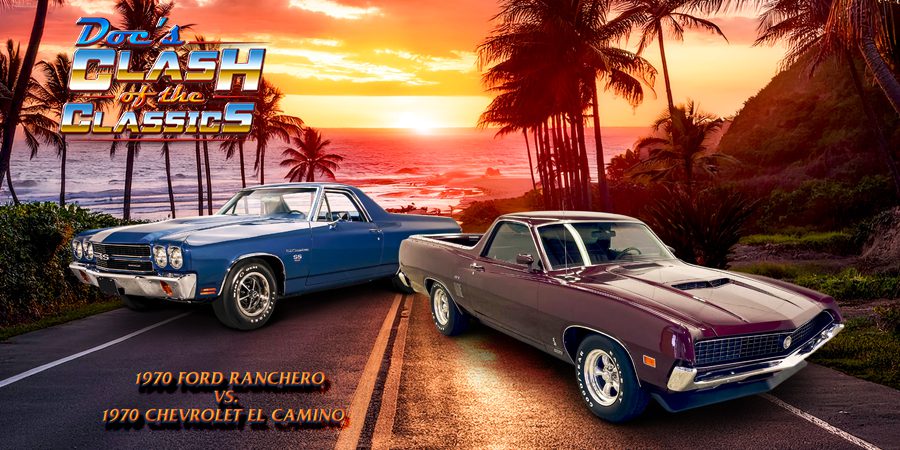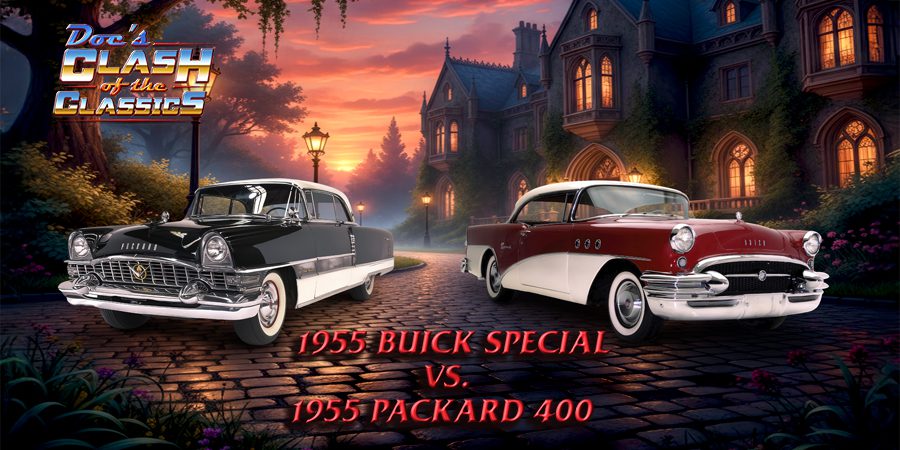Welcome, once again to Clash of the Classics. This month we’ll head back to 1970 to look at two of the most popular cars ever produced, the 1970 Ford Ranchero and the 1970 Chevy El Camino.
1970 was an interesting year in our nation, Led Zeppelin, one of my favorite groups growing up, released their third album, titled simply “Led Zeppelin III”. The movie “Patton” starring George C. Scott hit the theaters, and Jimi Hendrix passed away (much too soon) from a drug overdose.
In the automotive world, things between Ford and Chevy were heating up as both were looking to dominate a niche platform commonly referred to as the part car, part truck market.
The Ford Ranchero debuted in 1957 as a response to Chevrolet’s upcoming El Camino which we’ll look at a bit later. Unlike a traditional pickup, the Ranchero was based on a passenger car platform, giving it smoother handling and a more comfortable ride than its truck-based rivals. Over the years, it grew in size, power, and style, moving from a compact Falcon-based vehicle to a mid-sized machine rooted in the Fairlane and Torino lines.
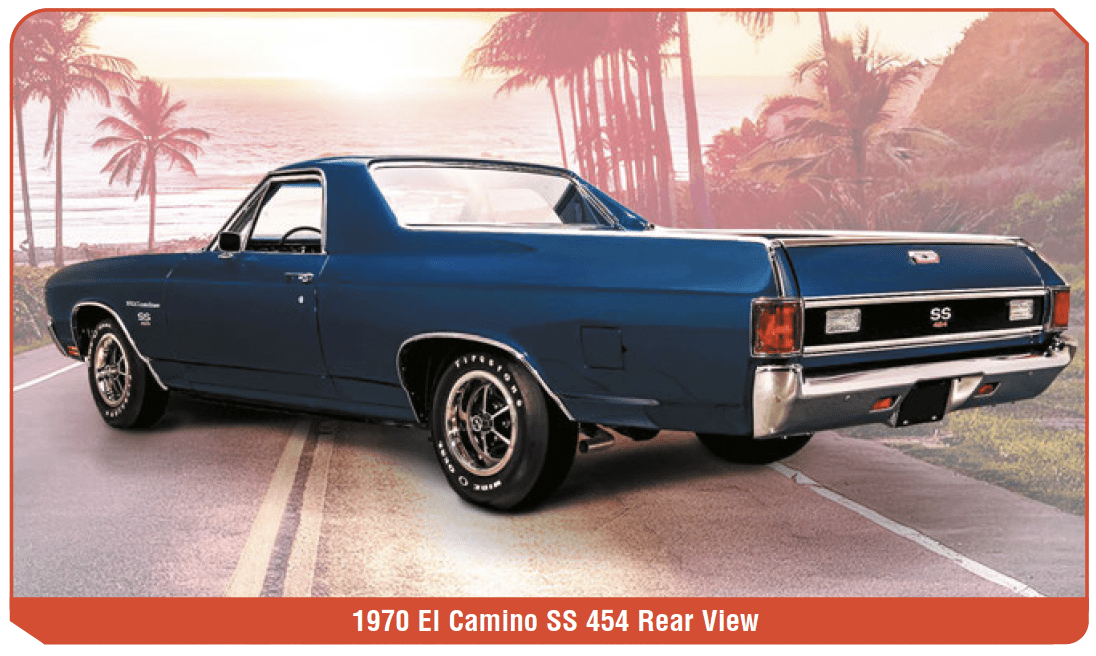 By the time the 1970 model year rolled around, the Ranchero had entered its fifth generation and adopted the swooping, aggressive lines of the freshly redesigned Ford Torino. This change aligned it with the muscle-car craze of the era, giving buyers a utility vehicle that looked just as good cruising Main Street as it did parked at a job site.
By the time the 1970 model year rolled around, the Ranchero had entered its fifth generation and adopted the swooping, aggressive lines of the freshly redesigned Ford Torino. This change aligned it with the muscle-car craze of the era, giving buyers a utility vehicle that looked just as good cruising Main Street as it did parked at a job site.
It was somewhat of a visual departure from its 1969 predecessor. The new styling for 1970 brought a long, sculpted hood, pronounced fender lines, and a “Coke bottle” profile that pinched inward at the waist before flaring over the rear wheels. The new look was a more sleek, athletic appearance, far removed from the boxier shapes of earlier years.
The new front styling included a recessed grille flanked by quad headlights, with some trims — like the sporty GT — receiving brightwork and badging that hinted at performance. The body lines flowed smoothly into the integrated bed, which featured a relatively low loading height, making the Ranchero both stylish and practical.
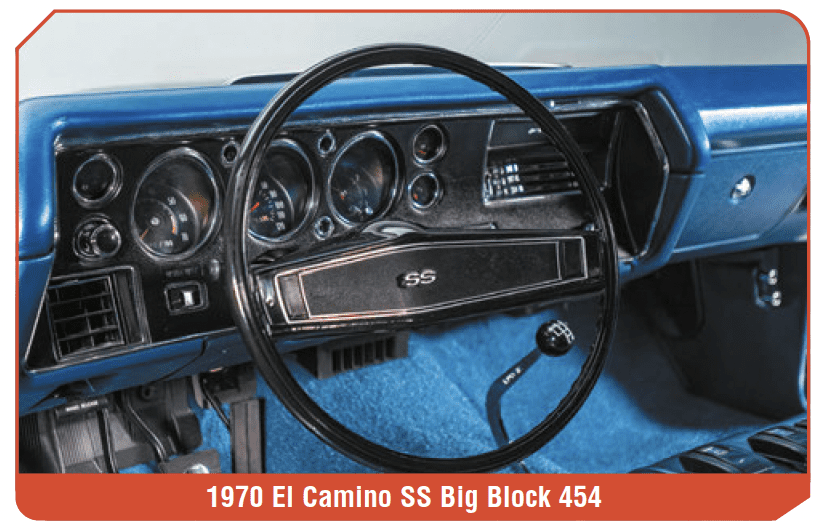 The 1970 Ranchero’s engine lineup reflected the performance diversity of the Torino. Base models started with a modest 250-cubic-inch inline-six, producing around 155 horsepower — adequate for light duty but hardly exciting. From there, buyers could step up to a range of V8 options:
The 1970 Ranchero’s engine lineup reflected the performance diversity of the Torino. Base models started with a modest 250-cubic-inch inline-six, producing around 155 horsepower — adequate for light duty but hardly exciting. From there, buyers could step up to a range of V8 options:
- 302 cubic-inch V8 – 220 horsepower
- 351 cubic-inch Windsor or Cleveland V8 – 250 to 300 horsepower, depending on configuration
- 390 cubic-inch V8 – up to 320 horsepower
- 428 Cobra Jet V8 – 335 horsepower, with Ram Air available for an extra punch
- 429 Cobra Jet or Super Cobra Jet – up to 375 horsepower for serious muscle
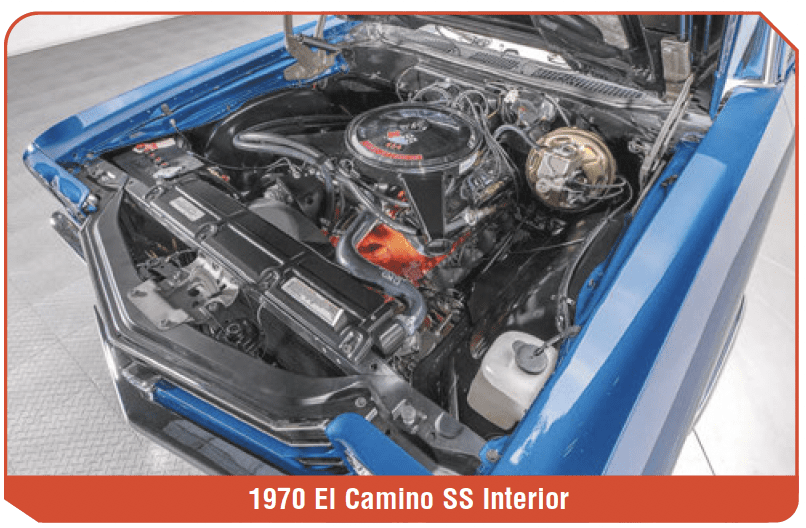 Transmission choices included a 3-speed manual, 4-speed manual, or 3-speed Cruise-O-Matic automatic. In high-performance form, particularly with the 429 Super Cobra Jet, the Ranchero could rival dedicated muscle cars of the era in straight-line speed, all while offering the ability to carry a halfton payload.
Transmission choices included a 3-speed manual, 4-speed manual, or 3-speed Cruise-O-Matic automatic. In high-performance form, particularly with the 429 Super Cobra Jet, the Ranchero could rival dedicated muscle cars of the era in straight-line speed, all while offering the ability to carry a halfton payload.
Options included air conditioning, AM/FM radios, power steering, and power brakes — luxuries that were far from standard in traditional pickups of the time. The Ranchero was designed to blend car-like comfort with utility, making it a favorite among buyers who needed practicality without sacrificing driving enjoyment.
Behind the wheel, the new Ranchero felt more like a Torino than a truck. Its coil-spring front suspension and leaf-spring rear setup balanced ride comfort with the ability to handle significant weight in the bed.
As the dawning of a new decade emerged, the Ranchero was more than just a niche curiosity; it represented the merging of two major American automotive trends: utility and performance. In rural areas, it offered genuine work capability. In suburban driveways, it was a conversation starter. And among younger buyers, it served as a cool, unconventional alternative to a muscle car or station wagon.
While the Ranchero never outsold Chevrolet’s El Camino, it maintained a loyal following thanks to its distinctive styling, wide range of configurations, and Ford’s broad dealer network. Today, the 1970 model year is considered one of the most desirable among collectors, particularly in high-performance GT or Cobra Jet form.
During our time broadcasting the show Horsepower for an Hour, we had several occasions to experience Ford classic vehicles. One such occasion was while we hosted the “Fabulous Fords Forever” show in Southern California. Every year some of the finest classic Fords in the country would make their way to the show for competition and camaraderie. During those shows, we were able to enjoy the driving experience of some of the coolest Rancheros ever built. While the 1957 model is clearly a fan favorite, this 1970 is not without serious appeal.
In a world where most vehicles are neatly divided into cars, trucks, and SUVs, the Ranchero remains a reminder that sometimes the best ideas come from coloring outside the lines. The 1970 model, with its Torino styling and muscle-car power, may just be the purest expression of that philosophy. Now, lets look at the Chevrolet El Camino.
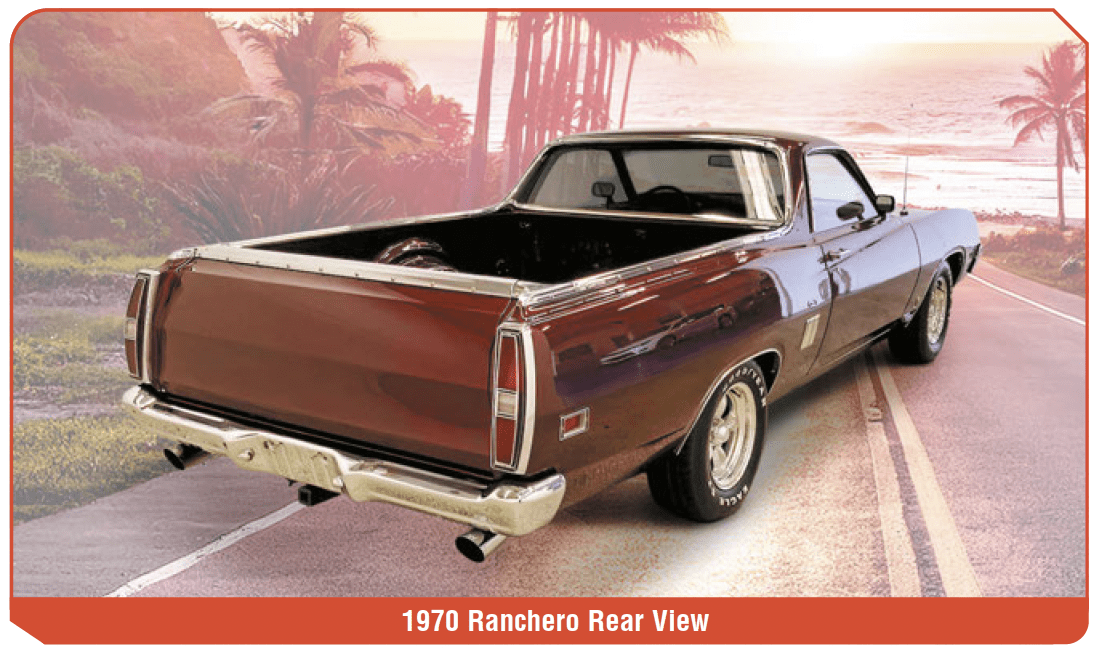 The 1970 Chevrolet El Camino is one of the most distinctive vehicles to come out of Detroit’s muscle car era — a machine that combined the performance and styling of a Chevelle with the utility of a pickup truck. By the dawn of the 1970s, Chevrolet had perfected the El Camino formula, and the 1970 model year in particular remains one of the most sought-after versions among collectors and enthusiasts. With its bold styling, powerful engine options, and unique “car-truck” appeal, the ’70 El Camino became an icon that blurred the line between workhorse and weekend warrior.
The 1970 Chevrolet El Camino is one of the most distinctive vehicles to come out of Detroit’s muscle car era — a machine that combined the performance and styling of a Chevelle with the utility of a pickup truck. By the dawn of the 1970s, Chevrolet had perfected the El Camino formula, and the 1970 model year in particular remains one of the most sought-after versions among collectors and enthusiasts. With its bold styling, powerful engine options, and unique “car-truck” appeal, the ’70 El Camino became an icon that blurred the line between workhorse and weekend warrior.
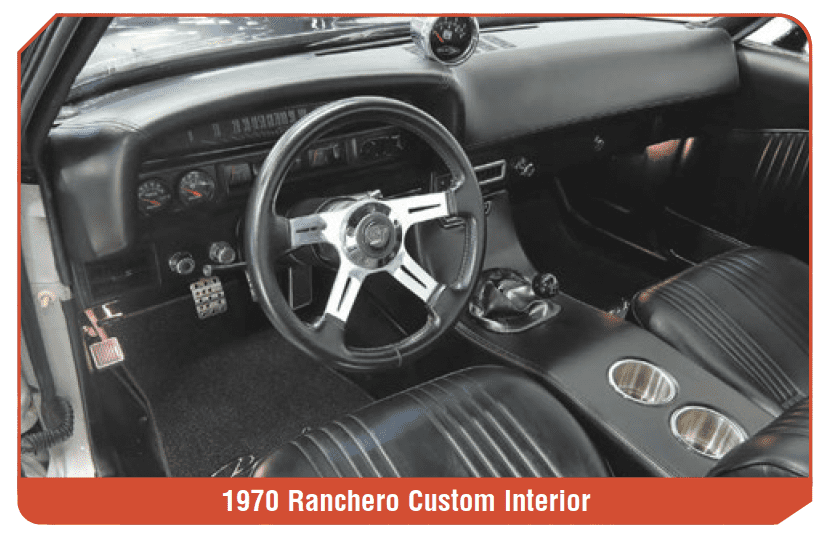 The El Camino wasn’t a new idea in 1970 — it had already been around for over a decade. Chevrolet first introduced it in 1959 as a response to the aforementioned Ford Ranchero, which debuted in 1957. The concept was simple: give customers the ride comfort and style of a passenger car, but with the open bed and hauling capacity of a truck.
The El Camino wasn’t a new idea in 1970 — it had already been around for over a decade. Chevrolet first introduced it in 1959 as a response to the aforementioned Ford Ranchero, which debuted in 1957. The concept was simple: give customers the ride comfort and style of a passenger car, but with the open bed and hauling capacity of a truck.
After a brief hiatus in 1961, the El Camino returned in 1964 on the midsize Chevelle platform, allowing Chevrolet to blend muscle car performance into the mix. By the late ’60s, the El Camino SS (Super Sport) variant had cemented its place in the muscle car world, offering big-block V8 power under the hood and aggressive styling cues that mirrored the Chevelle SS.
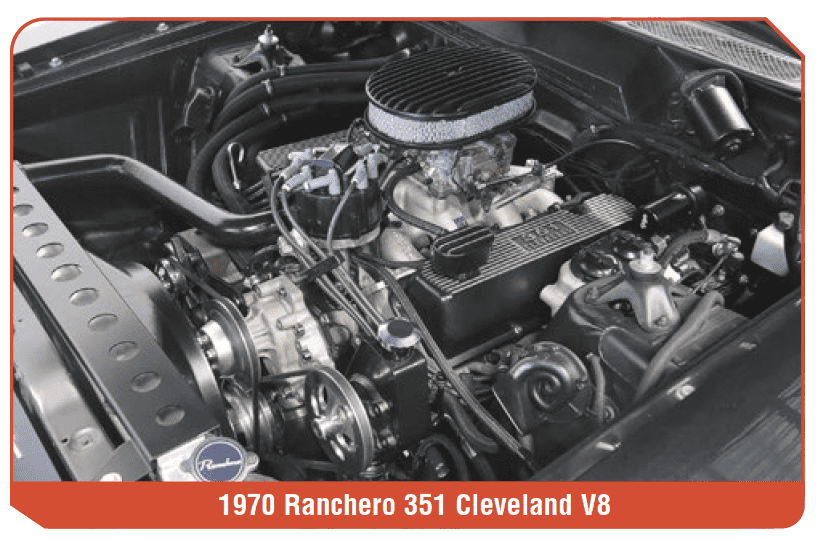 The 1970 El Camino received a dramatic restyling in line with the Chevelle lineup. The design became more aggressive, featuring a wider, more sculpted body and a split grille flanked by quad headlights. The rear received new taillights integrated into the bumper, giving the car a cleaner and more muscular stance.
The 1970 El Camino received a dramatic restyling in line with the Chevelle lineup. The design became more aggressive, featuring a wider, more sculpted body and a split grille flanked by quad headlights. The rear received new taillights integrated into the bumper, giving the car a cleaner and more muscular stance.
Buyers could choose from several trim levels, from the practical base model to the luxurious Custom, and the performance-oriented SS 396 or SS 454. The SS package added sport striping, “power bulge” hood, unique badging, and optional cowl induction, which used a vacuum-operated flap to feed cooler, denser air into the engine.
The interior was pure Chevelle — comfortable bucket seats, sporty gauge clusters, and available center consoles gave it a car-like feel, while the bed out back was ready for anything from a load of lumber to a set of drag slicks.
One of the biggest draws of the 1970 El Camino was its wide range of engine options. For buyers interested in economy and daily driving, Chevrolet offered 250-cubic-inch inline-six and small-block V8s ranging from 307 to 350 cubic inches.
However, for those seeking serious muscle, the SS models packed real heat. The SS 396 actually displaced 402 cubic inches that year (Chevy kept the “396” name for recognition), producing up to 375 horsepower. Even more notable was the availability of the new LS6 454-cubic-inch V8 — the most powerful engine Chevrolet had ever offered in a production car at the time. Rated at 450 horsepower and 500 lb-ft of torque, the LS6 turned the El Camino into a pickup that could outrun many dedicated muscle cars of the era.
Transmissions included a 3-speed manual, 4-speed Muncie manual, or a Turbo-Hydramatic automatic, allowing drivers to tailor the El Camino to their preferences. Rear-axle ratios and limited-slip differentials were also available for those serious about performance.
On the road, the 1970 El Camino drove much like its Chevelle sibling. The ride was comfortable for long trips, but firm enough to handle spirited driving. With a big-block V8 under the hood, acceleration was fierce — the LS6 El Camino could cover the quarter-mile in the mid-13-second range straight from the factory, an impressive feat for a vehicle with pickup utility.
The bed added weight over the rear axle compared to a Chevelle, which could slightly affect handling, but many owners appreciated the balance of performance and practicality. Few vehicles could haul a refrigerator one day and win a drag race the next.
The 1970 El Camino quickly became a favorite among hot-rodders, drag racers, and customizers. Its combination of muscle car power and pickup practicality made it a conversation starter wherever it went. Over the decades, it has appeared in movies, TV shows, and countless car shows, helping cement its status as a classic American icon.
In today’s collector market, the 1970 model is one of the most desirable El Caminos, especially in SS trim with the LS6 454. Original, numbers-matching examples can command high prices, while well-restored models remain popular among enthusiasts who appreciate their dual-purpose nature.
The 1970 Chevrolet El Camino represents a high point in the “car-truck” concept. With its bold styling, impressive performance options, and unmatched versatility, it captured the spirit of the muscle car era while offering something truly unique. Whether equipped with a modest small-block or the fire-breathing LS6 big-block, the ’70 El Camino proved that utility and excitement didn’t have to be mutually exclusive.
More than half a century later, it remains a symbol of American ingenuity — a vehicle that defies easy categorization yet continues to inspire admiration from both car and truck enthusiasts alike.
As is the case with all of our Clash of the Classics battles, there must be a victor in todays contest. While both of these cars are truly iconic, it is the El Camino that gets the nod today. While the Ranchero is certainly worthy of admiration, it is the overall cool factor of the El Camino that puts it over the finish line first for us.
As always, we’d love to hear from you, let us know which car you prefer and why.
Until next time when we take a ride on a classic highway, stay safe… stay timeless… stay classic!
About The Author
Donny Caccamise is an Automotive Technology Graduate and a Certified Master Technician with more than 40 years of automotive industry experience. Before retiring, he hosted the Nationally Syndicated Automotive Talk Radio Show “Horsepower for an Hour” airing on 161 AM and FM radio stations across the nation. He is a retired member of the ATRA Board of Directors, and retired transmission shop owner. Vintage and classic cars are his specialty. Contact Donny at donnycaccamise@gmail.com.


